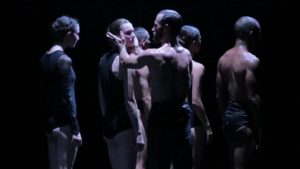OCD Love: L-E-V Dance company delves into a paradox, the strange psychic disruption of the troubled body!

This latest work by the Israeli dance company LEV Dance, created by Sharon Eyal and Gai Behar is a terrifyingly complex moment of corporeal inventiveness that subjected the dancers to the most demanding feat of choreography I have ever seen.
Physical dislocation of the body coupled with neurological disturbance , a mind dislocated by obsessive compulsive desires, appears to take possession of these human bodies, leaving these creatures transformed into life forms of questionable origin, projected from the psychic depths of Eyal and Behar who conceived this work.
A lone artist on stage during first few moments of the evening, a delicately sensitive creature performed by Mariko Kakizaki, defined by patches of shadows, of light, reacting to Ori Lichtik ‘s repetitive sound scape of tapping that recalled the sounds coming from the Neil Hilborn’s slam poem, the inspiration of this piece.
The young female dancer lifted herself on her toes, bent her body forwards and backwards, outstretched her arms as she seemed to pull her shoulders out of their sockets and work over each one of her muscles individually . It was never clear which way her head was facing as the dark shadows on portions of her body transformed her into an ensemble of moving parts that never quite fit. A terrible malaise hit home. What was happening to her? How was this extreme knotting of muscles and connecting tissue possible ?
Then, a lone male figure advanced slowly out of the shadows at the back and came slowly downstage walking with great assurance, stretching his neck, his arms, articulating every single joint in his shoulders. He appeared to be very self assured; his arms are frozen in a horizontal position, keeping him vertical and straight and sure, whereas the young woman was always bent over, changing her legs and arms into rounded shapes, lowered towards the ground, always assuming her abjection.
She emphasized the flexibility of her arms, her legs, and her waist, her back while the young male was upright and dominant. Exposing his torso, his back, and the muscles of his thighs. His right hand holding the top of his pants. A fixed stance that confirmed his superiority.
As the music swelled four other male figures entered in from the mist, imposing different forms of collective corporeal reactions. Jerking legs, twisting arms, twitching backs , rippling muscles, jumping taughtly in unison in groups of two, three and four. There were only 6 dancers but the choreography gave the impression that they were much more numerous, occupying the whole space of the Babs Asper Theatre by lifting their legs, by jumping in various directions, by rapidly shifting their movements and regrouping around the stage, moving together backwards and forwards as the dancers , responding to the music, slowly producing more lyrical moments that were , less frantic, but occupying the whole space with greater rapidity.
It became extremely exciting, emotions were fueled by the percussion, tension grew. Something was about to happen but it was not clear what that was. The men moved in groups of two, then groups of four, then groups of five while the lone woman at times was isolated, or surrounded, or manhandled, and she in defiance, in anger, defending her space. A reworking of Pina Bauschs famous Kontakt Hoff!
The music, the soundscape carried it all along as though it were a frantic slam poem that shifted arms, tightened legs, pointed toes in straight lines: These were bodies that seemed to have connecting points, that never connected. The bodies moved but did not click. An event of pure corporeal research that shocked, and disturbed and fascinated because of the complex interaction that folded and unfolded on the stage. Could we say that this choreography sought to transport the dancers back to the experimental dance labs of the early Bauhaus, of Oscar Schlemmer’s Triadic Ballet, or of Kandinsky’s theatre of pure form. Except that those body parts were all bathing in the bright colours of the geometric forms that interested Kandinsky whereas the L-E-V dancers, stretching the hip hop body to its ultimate possibility, were not twirling in circles nor stepping around the stage covered with geometric shapes but rather sinking in and out of the mists of expressionist madness that spread over the whole stage. Still the corporeal preoccupation seemed similar.
An astounding performance of immense originality and the wildest of daring that becomes almost cathartic for an unsuspecting public!
L-E-V OCD Love can be seen again this evening at 7h30 in the Babs Asper Theatre of the NAC
Reviewed by Alvina Ruprecht